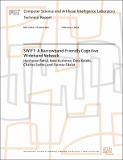SWIFT: A Narrowband-Friendly Cognitive Wideband Network
Author(s)
Sodini, Charles; Edalat, Farinaz; Katabi, Dina; Kushman, Nate; Rahul, Hariharan
DownloadMIT-CSAIL-TR-2010-001.pdf (1.482Mb)
Other Contributors
Networks & Mobile Systems
Advisor
Dina Katabi
Metadata
Show full item recordAbstract
Wideband technologies in the unlicensed spectrum can satisfy the ever-increasing demands for wireless bandwidth created by emerging rich media applications. The key challenge for such systems, however, is to allow narrowband technologies that share these bands (say, 802.11 a/b/g/n, Zigbee) to achieve their normal performance, without compromising the throughput or range of the wideband network.This paper presents SWIFT, the first system where high-throughput wideband nodes are shown in a working deployment to coexist with unknown narrowband devices, while forming a network of their own. Prior work avoids narrowband devices by operating below the noise level and limiting itself to a single contiguous unused band. While this achieves coexistence, it sacrifices the throughput and operating distance of the wideband device. In contrast, SWIFT creates high throughput wireless links by weaving together non-contiguous unused frequency bands that change as narrowband devices enter or leave the environment. This design principle of cognitive aggregation allows SWIFT to achieve coexistence, while operating at normal power, and thereby obtaining higher throughput and greater operating range. We implement SWIFT on a wideband hardware platform, and evaluate it in the presence of 802.11 devices. In comparison to a baseline that coexists with narrowband devices by operating below their noise level, SWIFT is equally narrowband-friendly but achieves 3.6x-10.5x higher throughput and 6x greater range.
Date issued
2008-08-17Citation
"Learning to Share: Narrowband-Friendly Wideband Networks", ACM SIGCOMM 2008
Series/Report no.
MIT-CSAIL-TR-2010-001
Keywords
Cognitive Radios, White Spaces, Cognitive Aggregation, Wideband, Wireless Networks